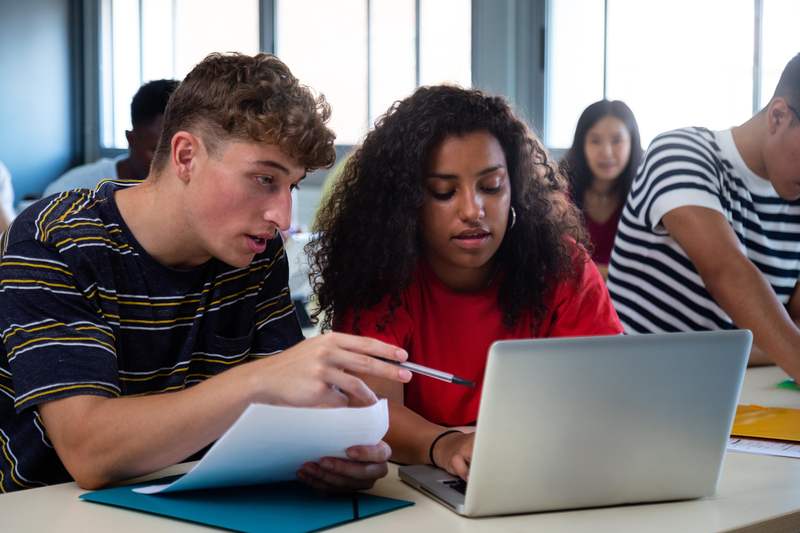When I took on the role of DEI coordinator at my school, what I really wanted to do was support teachers in developing approaches to instructional design that would make their lessons more diverse, equitable, and inclusive. I imagined arranging a multi-year series of toolbox shares, book studies, teacher-led workshops, peer observations, and coaching sessions. These would be centered on how to design lessons, discussions, assignments, assessments, and policies such that all students would see themselves reflected in their learning, engage authentically with their work, have access to everything they need to be successful, and feel a deep sense of belonging in the classroom.
But the work I ended up doing never touched teaching and learning. I was more of an event planner: I made spreadsheets of age-mixed groups for Diversity Day, handed out T-shirts at diversity conferences, and ordered pizza for diversity lunches. I wrote a set of FAQs about affinity groups and booked rooms for the group meetings. I spent a lot of time collaborating with colleagues, students, families, and administrators to ensure our DEI programs went well. Most of them did, but I don’t think any of them had an impact on students’ day-to-day learning experiences.
At workshops and conferences, I met other school DEI coordinators whose experiences were similar. They, too, created programs for students, such as Black History Month assemblies and community days. While these programs require effort and skill to produce—and can positively impact school communities—I sensed a familiar frustration. Too much of the work we were doing under the banner of DEI did not actually make our school more diverse, equitable, or inclusive. Instead, these programs compensated for a lack of diversity, equity, and inclusion in our schools.
From Compensatory to Transformational
Compensatory DEI is any program, event, or initiative that offsets—or compensates for—a lack of diversity, equity, and inclusion without changing the institution’s fundamental practices. I’ve sometimes heard people refer to compensatory approaches as “quick fixes,” or “Band-Aids,” but compensation is important. Our civil justice system is built on compensating those who have been harmed (even if the harm-doer meant no harm). The difference between compensatory and systemic DEI is not one of speed or depth, but of purpose. Compensatory approaches make up for something that’s missing from what we do. Systemic approaches transform how we do what we do.
Compensatory approaches make up for something that’s missing from what we do. Systemic approaches transform how we do what we do.
While compensatory programs can raise awareness of bias and prompt reflection on how our biases shape our actions, noticing our biases doesn’t make them go away, and knowing that we shouldn’t act upon our biases doesn’t tell us what to do instead. At worst, compensatory programs can actually reinforce bias by relegating historically marginalized groups to marginal programs.
For example, our school had affinity groups for various identities, invited diverse speakers, and held listening sessions after traumatic events. While these programs were important—giving students safe spaces, raising awareness of the issues of diverse communities, and creating opportunities for connection—they didn’t transform our core instructional practices or daily teaching routines. Affinity groups didn’t make instructional spaces more inclusive; visiting speakers didn’t diversify our day-to-day curriculum; and listening sessions didn’t change how faculty meetings or class discussions functioned. Systemic transformation, by contrast, would require changing how we teach, how we design curriculum, and how we structure students’ interactions with the content and each other.
So, how do we move toward systemic, instructionally integrated approaches?
Changing the Grammar
Rather than only viewing diversity, equity, and inclusion as programs, we can also see them as values we can apply to all aspects of schooling—how we structure lessons, discussions, assignments, class placement, discipline, and everything else. Diversity, equity, and inclusion become qualities we can bring to any practice, anywhere, anytime. Doing that requires a shift in grammar.
How can we use a variety of activities, groupings, and modalities to help our students understand and respond to material?
As nouns, “diversity,” “equity,” and “inclusion” make it easier to talk about these ideas, but they also mislead us into thinking of them as things. They’re not. They’re qualities. Typically, when we’re naming the qualities of a thing, we use adjectives: “a purple shirt,” “a quick break,” “a favorable outcome.” Adjectives make little sense without the noun; if someone asked you with no context for “a purple,” you’d most likely reply, “A purple what?” When we use the adjective forms of diverse, equitable, and inclusive, we’re describing our practices. Let’s look at a few examples.
Class discussions:
- Diverse discussions encompass a variety of groupings, structures, and topics.
- Equitable discussions provide everyone with the tools and resources they need to make a meaningful contribution.
- Inclusive discussions enable everyone to contribute something meaningful, feel heard, and respond thoughtfully to one another.
Assignments:
- Diverse assignments ask students to create various types of work.
- Equitable assignments provide all students with everything they need to complete their work successfully.
- Inclusive assignments are written such that every student will be able to use it as an opportunity to create something meaningful to them personally and in the world.
Responses to harm:
- Diverse responses to harm might encompass a wide variety of interventions, such as having a reflective conversation, making repairs, finding replacement behaviors, and forming mentoring relationships.
- Equitable responses recognize that problem behaviors often stem from underlying challenges. These responses address those challenges while holding the harm-doer accountable for their actions.
- Inclusive responses not only hold the harm-doer accountable, but also care for the harmed person or group and hold accountable anyone in the community who enabled or failed to prevent the harm.
We can put these adjectives in front of any instructional or institutional practice: diverse projects, equitable scheduling, inclusive faculty meetings, diverse counseling services, equitable recess equipment, inclusive evaluations, and on and on. Once we see that it’s possible to put the adjectives in front of activities teachers already do, we can begin to imagine what our existing practices could look like and what it might take to transform our daily work.
Language Is Key
Schools don’t need a consultant or expensive program to integrate more responsive and inclusive approaches into their everyday practices; they need to shift the language of DEI from nouns to adjectives and use those adjectives in questions about their work with students. For example, when my colleague and I start planning our unit on A Midsummer Night’s Dream, we can ask ourselves:
- How can we make this unit diverse? That is, how can we use a variety of activities, groupings, and modalities to help our students understand and respond to the play?
- How can we make this unit equitable? That is, how can we ensure every student has everything they need to be successful readers of this play—according to our definition of success as well as theirs?
- How can we make this unit inclusive? That is, how can we invite and enable every student to read, think about, and respond to the play in ways they find meaningful?
Just as these questions could guide an English department’s unit planning, questions about responses to harm could guide an administrative team in developing a diverse, equitable, and inclusive discipline policy. Really, anyone can imagine ways to make their practices more diverse, equitable, and inclusive by exploring how these adjectives could describe the things they do.
Try it yourself: Set a timer for two minutes, and during that time, make a list of ways you could complete the sentence, “As part of my work at school, I. . . .” Try to think of the various parts of your job, from the big responsibilities to the granular daily tasks. When I was a middle school English teacher, my list might have said plan units, lead discussions, write assignments, give feedback, email parents and guardians, arrange desks, put students into groups, post handouts, and so on.
Now choose one item from your list that you want to think about more deeply, perhaps because it’s important or interesting to you, or perhaps because your school has made it a priority this year. Ask yourself questions (see fig. 1) about this practice and consider how you can make it more diverse, equitable, and inclusive.
Leading Real, Classroom-Level Change
After a few years as a DEI coordinator, I gave up the position and went back to teaching four sections of English. I wasn’t given the power or authority to curate the professional development series it would have taken to make students’ classroom experiences more diverse, equitable, and inclusive. Since I’m better at instructional design than program administration, I figured I’d have a bigger impact on students’ lives if I focused my efforts on my classroom.
All these years later, I wonder how many other DEI coordinators have stepped down or left their schools out of frustration that they couldn’t do the system-wide work they knew they and their colleagues were capable of. I also wonder about all the DEI professionals who didn’t leave their jobs and are now being forced out. Some schools are rebranding their DEI programs, renaming Diversity Day as Community Day or retitling the DEI office the Office of Belonging and Social Impact, to escape political scrutiny and preserve their work. But long before the backlash against it, DEI was often separate from schools’ core work of teaching and learning. Making diversity, equity, and inclusion fundamental qualities of instruction treats this work as integral to the work of school, no matter what we call it. And it’s just good teaching.
Teach for Authentic Engagement
Strategies, tools, and classroom anecdotes that help students authentically engage with the content, with their work, and with each other.










